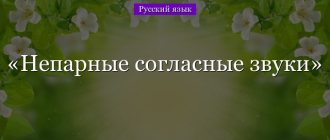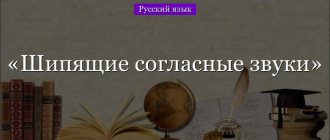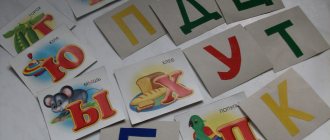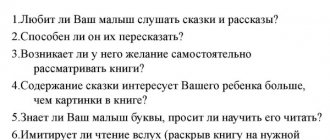Introducing a child to the Russian alphabet is always an encounter with an unknown but mysterious world, in which there are so many interesting things.
The letters of the Russian alphabet make up a whole family, with 33 inhabitants!
And everyone needs to be remembered in their places. But the study of letters does not end there. We also have to divide them into vowels and consonants, stressed and unstressed, soft and hard, voiceless and voiced . And this is still far from a complete classification. Let's figure out how to correctly divide the letters of the alphabet into groups.
What are speech sounds and letters?
When learning a language with your child, you need to clearly make him understand the differences between spoken and written language. To do this, it is important to give him the concept of what a sound is and what a letter is.
Sounds are what we perceive with our ears. Our brain easily separates what relates to speech from other sounds and interprets them into images. We can write down the sounds of speech in letters, forming words from them.
A letter is a graphic symbol of the alphabet, thanks to which we can display on paper what we hear by ear. But here lies a very big difficulty for the child. After all, the number of sounds and letters that reproduce them on paper in different words may differ in one direction or the other.
How many letters and sounds are there in the Russian language and alphabet and their relationship
IMPORTANT: We hear and can produce sounds with our speech apparatus. We can see and write letters! Sounds exist in all languages. Even in those where there is no written language.
In a word like “chair,” the letters correspond to the sounds. But in the word “sun”, the letter “L” is not pronounced. “Ъ” and “b” are not pronounced . They only slightly change the pronunciation of the words in which they are used.
There is also such a “school” word as “Compasses” . In which instead of the sound [I] [Y] is pronounced .
There are still a lot of words in the Russian language that are pronounced differently from how they are written in letters. Therefore, it is very important for a child to learn to correctly understand this difference.
What is a vowel sound?
Vowel sounds are the minimum unit of speech, which is pronounced only with the help of the voice. Ways to form vowel sounds:
- [a] let's create with the help of a wide-open mouth: rAb
; - [o] we get if we round the lips: kOt
; - [y] will appear when you stretch your lips into a tube: steering wheel
; - [and] we will hear if we stretch our lips into a smile: whale
; - [s] is formed by slightly stretched lips and a slightly pulled back tongue: сыр
; - [e] – we stretch our lips horizontally without opening our mouth wide: Echo
.
Alphabet
Language is the main invention of mankind. Moreover, for every nation that has created its own language, it is distinguished by the characteristics peculiar to this people. At a certain stage in the development of a community that a particular people uses, there appears a need to record speech sounds combined into words and sentences. This is how writing appeared, and at the same time the alphabet. That is, a set of all the letters used in writing, standing in strict order.
The Russian alphabet has 33 letters and looks like this:
The order of letters in the Russian alphabet
The alphabet is the basis of any language that everyone who studies it needs to know. Is it possible to learn to speak without knowing the alphabet? Certainly. But, in addition to the ability to express your thoughts, you need to learn to write and read. And this is impossible to do without knowing the alphabet.
Today, children have a lot of different aids for learning the alphabet. You can buy special flash cards, magnets, and a small primer that your child can take with him on walks or trips.
In our computerized era, electronic gadgets can also be called upon to help in learning the alphabet. Type letters in text apps and name the sounds that teach them. You can use your imagination and use graphic editors, change fonts and add fills. Create your own alphabet that will be interesting to your child. Then learning will go faster and more efficiently.
INTERESTING: Teachers have come up with a very interesting and exciting way to learn the alphabet. Dedicate each new day in your family to one of the letters of the alphabet. Of course, we shouldn’t forget about the rest. Bake buns in the shape of letters, make letters from plasticine with your child, draw them, assemble them from counting sticks. Be sure to tell about the letter the day is dedicated to and give examples of its use.
Vowel sounds and letters
Introducing your child to the alphabet is a very exciting activity. But this is only one of the first steps in mastering the language. To continue studying its elementary units, you need to learn how to divide them according to their characteristics.
Those letters that are pronounced drawlingly are called vowels.
- There are 10 vowel letters in the Russian language: “A”, “E”, “Ё”, “I”, “O”, “U”, “Y”, “E”, “Yu”, “Ya”
- 6 vowel sounds [a], [o], [u], [e], [i], [s]. Typically, vowel sounds in the school curriculum should be highlighted in red.
We have already clarified the difference between the elementary particles of language.
The letters Ya, Yo, Yu, E are iotized. They involve one or two sounds.
From this table, this difference can be seen again:
INTERESTING: By the way, about the letter “Y”. Today it is mistakenly believed that Karamzin introduced it into our alphabet. But that's not true. This was done by the director of the St. Petersburg Academy, Princess Ekaterina Dashkova, on November 18, 1783 at a meeting on the occasion of the creation of the first explanatory dictionary in Russia. She suggested changing the letters “IO” to one “E”.
How did vowel sounds appear?
The modern alphabet has ten vowel letters: a-ya, o-e, u-yu, y-i, e-e.
The history of vowel letters is quite fascinating. For the first time, all alphabetic signs were collected into a single alphabet by the monastic brothers Cyril and Methodius. Consonants and vowels of the Russian language, which came from Greek, appeared in the Cyrillic alphabet. Each vowel letter of the Russian alphabet has its own history.
The letter a"
The first letter is A in the alphabet,
You will definitely learn it.
Our dear, glorious little letter,
There is no sweeter and more beautiful woman in the world.
“Ahh,” is sung in every chant.
We will sing it amicably and together.
A is the very first letter of the alphabet, previously written as “Az”. The first mention of this vowel appears in an ancient manuscript from the 12th century. Since its appearance, it has been modified several times. At first, uppercase and lowercase letters were written the same way and differed only in the height of the letter.
Only later did the style become different: “A is a capital letter, and a is a lowercase letter.” There is also a capital version (Aa), however, like all other letters of the Russian alphabet.
According to scientists, this sound comes first because of the simplicity of pronunciation; it sounds briefly as you exhale: “A”.
Letter "E"
Here's a donkey from Bremen,
“E-ee-ee” - we’ll sing with him.
Let's open our mouths, smile,
There are two sounds right away.
In the distance we hear
The sound is short and we don’t write it.
This is the sixth letter of the Russian alphabet, which denotes the long sound ['E] - forest, oar. In individual words, this letter denotes two sounds [Y'E] - spruce, food. It comes from the Greek version of the letter Ʃ - “epsilon”. And later it began to be written as the Latin “E” and acquired two variants of style.
The letter “e” is used quite often and ranks second in frequency of use in speech.
Did you know that this letter was not previously in the Cyrillic alphabet? There was only one short sound - E, but over time they added a vowel of a longer sound - “E”.
Letter "Y"
The letter "Yo" is rarely used. The letter E names one sound ['O] or two sounds at once [Y'] and [O]. The letter, like all others, has different styles, changing its appearance quite significantly.
This letter is the youngest in our alphabet. It was invented by N.M. Karamzin is a famous Russian writer. The President of the Russian Academy, Princess E.R., liked the idea. Dashkova and on October 10, 1918, the letter E became an equal participant in our alphabet. In 1942, the use of this letter became a mandatory rule for writing texts in Russia.
Letter "I"
Smile widely
Exhale easily.
Adding sound to a smile
We sing “And” without error.
In the alphabet, the letter “I” occupies ninth place. Originally it had three spellings: I, I, V. Each letter stood for a specific number. Over time, the style I was established in one version; in the modern alphabet it has uppercase, printed, lowercase, and capital variants.
Letter "O"
The letter "O" occupies the sixteenth position in the alphabet. Indicates one sound: [O]. This letter is used most often in the Russian language. It can also be an interjection that expresses an exclamation of surprise or admiration. For example: “Oh, what a dress!” Or a pretext to connect words in a sentence: talking about mom. The appearance of this letter is associated with the Phoenician language, in which there was such a letter as “omega”. O came to our language modified, has a capital and printed version of the style.
Letter "U"
Let's sing this song together and pretend how a top howls. Curl your lips.
We met a wolf in the forest:
“Don’t be afraid, I’ll sing!”
Say loudly: "Uh,
I live a very happy life."
We sang with the wolf together,
Tomorrow we'll go to the forest again!
This letter ranks twenty-first in the alphabet. It is very easy to pronounce and not tricky at all. As we hear, so we write - wow! The frequency of pronunciation of the letter is only two percent of the entire text. Like other capital letters of the Russian alphabet, it has its own ways of writing.
And this letter came from the Greek sign “Y” - upsilon. Until the 15th century, the letter was used as a combination of two characters “O” + “Ƴ” (Izhitsa).
And this letter can also be a preposition - to connect two words: stand at the threshold.
Or interjection: Uh! What a prankster you are!
The vowel letter "Y" has only a lowercase spelling. If you compare the sounds [I] and [Y], they sound similar. This is a very tricky vowel. I just want to write Y in some words instead of I. The Russian language has many spelling rules related to the vowel ы. For example: “Zhi-i shi” write with the letter i” (life, wide). Knowing the letters and rules will help you avoid mistakes in spelling words.
The appearance of the vowel ы is associated with the Slavic alphabet. It is believed that it came from Ъ and I, which is why it was written as ЪI.
The letter “e” is in thirty-first place and denotes one vowel sound [e]. Most often found at the beginning of some foreign words: era, exam, floor. This letter appeared relatively recently, it was introduced by Peter 1. It finally entered the Russian alphabet in 1735, but it seemed ugly to M.V. Lomonosov. But Academician Ya.G. Grote defended this letter, saying that there was no way to do without it. And I turned out to be right, now this letter is simply irreplaceable.
The modest letter stands thirty-second. It is the eighth most frequently used and is rarely found in Russian words. But this is a very insidious letter of the Russian alphabet, because it plays two roles. Firstly, it denotes the softness of the consonant sound that precedes it: l' yuk, r' yusha. Secondly, it denotes two sounds - [y'u], for example, at the beginning of a word: [y'ula]-yula, [y'ubka]-skirt. This vowel appeared earlier than all iotated sounds.
This is the last vowel letter; in the Russian language it is not used very often, occupying sixth place among others. And it also plays two roles: the designation of the softness of the consonant sounds that come before it (m'yaso) and the designation of two sounds, for example, [y 'ama] - pit. Derived from the Old Russian letter “yus small” - Ѧ. In 1978, it was introduced by Peter 1, from which time the letter “yu” became an obligatory part of the Russian alphabet.
Stressed and unstressed vowel sounds
- The stressed vowel sound is pronounced with great force and does not undergo changes.
For example : sn e g, st ý l, shk a f
- The unstressed vowel sound is pronounced with little force and undergoes changes.
For example : k O rzina (heard instead of O , sound A ), m E dved (In the first unstressed vowel sound, instead of E , heard I ), pl E cho (vowel sound I is heard instead of E ).
IMPORTANT : Stress is not placed in words with one syllable and in words with the letter E.
Vowels Yotated letters Ya, Yu, E, Yo soften the consonant sound in front of them and create one sound: e → [e] or [i], е → [o], yu → [u], i → [a ].
For example:
- At the beginning of the word: hedgehog [y'ozhik]
- In the middle of the word: shelter [pri y'ut]
- At the end of the word: gun [roug y'o]
Hard and soft vowels have a direct effect on consonants. For example, the consonant letter “P” can be either hard (in the word “package” ) or soft (in the word “cookie” ).
The difference between vowels and consonants
We already talked about how to distinguish vowels from consonants in the previous lesson. So let's play a little to remember this topic.
There are letters in front of you, try to sing each of them. After this, determine in which carriage the letters live.
Distribute the letters. What is the name of each carriage?
Answer: 1 car – vowel sounds i, u, y, o, a, yu; 2 car – consonant sounds l, b, zh, v.
The main difference between vowels and consonants is the way they are pronounced and formed. Thus, consonants encounter an obstacle in the mouth, but vowels do not encounter obstacles when pronouncing and directing the air flow forward.
Exercise
Practice expressive reading so that you can sing every vowel. Read it to your loved ones and try to cheer them up.
Every child from the 1st grade learns to read and write. To know everything, you need to be diligent. First, learn the alphabet and memorize the vowels and consonants. The ability to read is the most important thing. I love Russian language!
Guys, this concludes our music lesson. Before passing the last test - the test, let's get up and play vowels.
Consonant letters and sounds, soft and hard: table
Consonants, like vowels, can be either hard or soft. For example, in the word “River” , the letter “R” is soft, and the word “Hand” is hard. In general, several factors influence the softness and hardness of sounds in a word. For example, the location of a sound in a word. The sounds are softened by iota vowels ( "E" , "Yo" , "Yu" and "I" ) and diphthongs that come after consonants. For example:
- "White"
- "Love"
- "Friday"
“I” also softens sounds , and its antipode “Y” , on the contrary, makes the sound hard. The presence of a soft sign at the end of a word plays an important role:
- "Len" and "laziness"
A soft sign can soften the sound, even if it is inside a word:
- "Skates"
Consonants
Consonant sounds form a voice and noise that occurs as a result of an air stream overcoming obstacles in the oral cavity (teeth, closing and opening of lips, etc.).
Voiceless consonants
With the help of noise, voiceless consonants, soft and hard, are formed:
[p] - [p'], [k] -[k'], [f]-[f'], [t]-[t'], [s]-[s'], [x]-[ x'], [h'], [w], [w',] [ts].
Voiced consonants
in the formation of voiced
Voiced consonants have pairs based on hardness/softness:
[b]-[b'], [c]-[c'], [g]-[g'], [d]-[d'], [z]-[z'], [l]-[ l'], [m]-[m'], [n]-[n'], [p]-[p'], as well as [th'], [zh], [zh'].
The long soft sound [zh'] occurs in a small number of words:
yeast, reins, ride, squeal, grumble, etc.
How to explain hard and soft consonants to a child
The task is not easy. If your child knows letters, start with a simple story about how vowels surrounded consonants and began to command them. Yes Yes. In war it’s like in war. These sassy vowels decide whether the consonant sound will be hard or soft.
There are a couple of rebels to whom this rule does not apply.
Ts, Zh, Sh are only hard, and Ch, Shch and Y are soft under any circumstances. We add rebels to the “black” list and place it on the most popular place in the house, for example, on the refrigerator, so that their glorious names are etched in the child’s memory. Don’t forget about the soft sign, which, by its appearance, easily decides the fate of hard and soft consonants.
The rest are less fortunate: if after the consonant there is A, O, U, E or Y, the sound is hard and is indicated by a blue brick or circle; if behind the “captive” there is E, E, Ya, Yu or I, it is soft and is indicated by green.
Did your efforts not bring the expected results? Draw attention to the position of the tongue when pronouncing paired hard and soft consonants.
Offer to turn a hard sound into a soft one, using different vowels: pa - pya, sa - sya, pu - pyu, su - syu, etc. A similar game can be complicated by changing the words: “corner - coal”, “rad - row”, bow - hatch" and others.
If after a consonant there is its equally consonant brother, the sound is hard. For example, in the word “candy” there is an “f” after the “n”. We can confidently say that in this case “n” is hard.
By developing the ability to distinguish between hard and soft consonants, you help the child develop auditory attention and phonemic awareness, which is important when teaching a child to read and write. This way you lay the foundation for success in school.
Video lesson “Consonant sounds and their letters”
Voiceless and voiced consonants in Russian: table
Consonants can be voiced or unvoiced. Voiced sounds are obtained with the participation of the voice in the formation of sound. Whereas in the formation of a dull sound, the voice practically does not play its creative role.
Voiced consonants
are formed by the passage of an air stream through the mouth and vibration of the vocal cords. Thanks to this, consonants such as:
When forming voiceless consonants
the vocal cords remain relaxed. These sounds are:
To make it easy to remember voiceless consonants, remember the expression: STYOPKA DO YOU WANT A CHEEK? - FI! All consonants in these words are voiceless.
If you delete all the vowels from this expression, only voiceless consonants will remain.
Paired and unpaired voiced and voiceless consonants: table
In the Russian language, it is customary to distinguish pairs of voiceless-voiced consonants:
The remaining consonants are unpaired:
Sometimes there is “forced” deafness or sonority of a consonant sound. This occurs due to the position of the sound in the word. A frequent example of such a forced state is the words: pond [rod] and booth [butka] .
Sonorants are voiced unpaired consonant sounds. There are only 9 of them: [th'], [l], [l'], [m], [m'], [n], [n'], [r], [r']
Noisy consonant sounds - there are voiced and voiceless:
- Noisy voiceless consonants (16): [k], [k'], [p], [p'], [s], [s'], [t], [t'], [f], [f '], [x], [x'], [ts], [h'], [w], [w'];
- Noisy voiced consonant sounds (11): [b], [b'], [v], [v'], [g], [g'], [d], [d'], [g], [z ], [z'].
Summary table of commonly used soft and hard letters and sounds in the Russian language:
Cartoons on the topic
To help your child quickly learn the division of letters into vowels and consonants, you can offer him cartoons on this topic. On our website you will find educational cartoons dedicated to this topic.
Speech therapist. Russian alphabet
This video presents sounds in the Russian language using examples of onomatopoeia. This technique will allow children to practice the clarity of pronunciation of vowels and consonants, and to more clearly feel the difference in their sound. Sounds accompany bright pictures with animals and natural phenomena. You can watch the cartoon here
Learn and sing the Russian alphabet
This video contains a performance of the alphabet to music. The melody is pleasant, easy to remember, and the song itself is accompanied by a display of the letter and form of its writing. This cartoon can be useful for children of any age, as it is aimed not only at remembering the order of letters, but also at practicing diction. You can watch the cartoon here
Voiceless consonants
There is a generally accepted opinion that it is impossible to sing consonants. However, the authors of this cartoon break the usual stereotypes of perception. Of course, this video cannot be called a song in its entirety: rather, we will be dealing with a drawn-out pronunciation of voiceless consonants. This is extremely useful for children's diction, in which defects in the pronunciation of hissing sounds are constantly visible. Play this cartoon for your child more often so that he corrects his diction. You can watch the cartoon here
Sibilant consonants
The consonants “Zh” , “Sh” , “Ch” and “Shch” are called hissing. These letters add some zest to our language. At the same time, they make it very difficult. Even while learning these letters, the child should know the rules:
- “ZHI” - “SHI” write with “I”
- "CHA" - "SHA" with the letter "A"
- “CHU” - “SHCHU” with the letter “U”
The letter "Zh" is voiced, and the other three ( "Ch" , "Sh" and "Sh" ) are unvoiced. An important feature of these sounds is that they cannot be pronounced without opening the mouth. Compare their pronunciation with the pronunciation of "M" or "N" . To pronounce sibilant consonants, there must be a gap between the lips through which air will escape, creating an acoustic accompaniment for these sounds.
The letter “and short” denotes the consonant sound th
The letter “Y” or “I short” is found in almost all Slavic alphabets, as well as in those non-Slavic alphabets that use the Cyrillic alphabet. In the Russian alphabet this letter occupies 11th place. It was formed from the vowel “I” and the voiced consonant “J” .
It is interesting that in the 18th century, when the civil script was introduced (as opposed to the church script), all superscript characters disappeared from it. And the letter “Y” has lost its important part. At the same time, the sound denoted by this letter “did not suffer” from such reforms. to return “Y” to the letter under Peter I. However, it was not returned to the alphabet. This was done only in the 20th century.
Today, more and more philologists classify the sound “Y” as a sonorant consonant. That is, those sounds that are located between vowels and consonants, but still relate to a consonant. In addition, it is always considered soft.
How many sounds can a vowel make?
Say these words, “singing” the first vowel sounds: hedgehog, pit, spinning top, spruce.
Listen to them. When pronounced, we will hear two sounds:
- [yo]zh;
- [ya]ma;
- [yu]la;
- [ye]l.
The letters E, E, Yu, I represent two sounds, because it is joined by the soft sonorant consonant Y (yot).
Compare with words: watermelon, needle, hoop, rat, equator
. Here the sounds [a], [u], [i], [o], [s], [e] are clearly pronounced. The letters A, U, Y, I, O, E have one sound.
Letters and sounds tape for elementary school
Various manuals help very well in learning the Russian language. One such manual is “The Summer of Letters” . It helps to understand the difference between letters, quickly develop reading skills in children and facilitate phonetic analysis of words.
Although at first glance the “Tape of Letters” contains a minimum of information, this is far from the case. This manual can be used not only at school, but also at home. Parents can independently teach their child literacy using this tool.
a “letter tape” at an office supply store or make it yourself. For example, you can use this diagram.
Scheme "Ribbons of letters"




